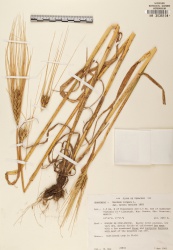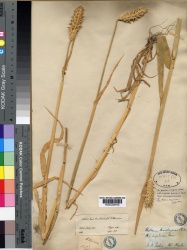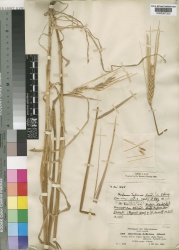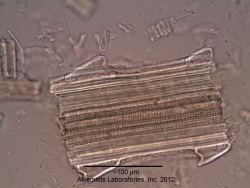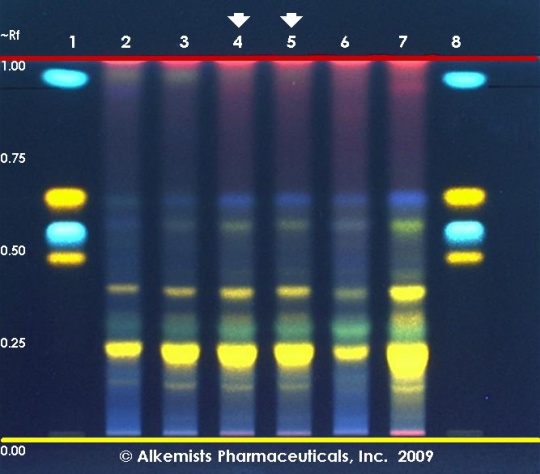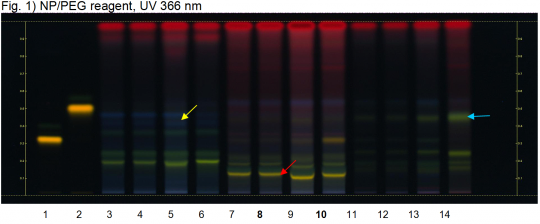Hordeum vulgare (leaf)
Contents |
Nomenclature
Hordeum vulgare L. Poaceae
Standardized common name (English): barley
Ayurvedic name(s): yava
Pinyin name(s): mai ya (dried germinated ripe fruit)
Botanical Voucher Specimen
 |
 |
|
|
|
|
|
Organoleptic Characteristics
Macroscopic Characteristics
|
Microscopic Characteristics
 |
 |
|
|
|
High Performance Thin Layer Chromatographic Identification
|
Barley (leaf) (Hordeum vulgare) Lane Assignments Lanes, from left to right (Track, Volume, Sample):
Reference materials used here have been authenticated by macroscopic, microscopic &/or TLC studies according to the reference source cited below held at Alkemists Pharmaceuticals, Costa Mesa, CA. Stationary Phase Silica gel 60, F254, 10 x 10 cm HPTLC plates Mobile Phase ethyl acetate: glacial acetic acid: formic acid: water [10/1.1/1.1/2.4] Sample Preparation Method 0.3 g + 3 ml CH3OH sonicated + heated @ 50° C ~ 1 hr Detection Method Natural Product Reagent + PEG -> UV 365 nm Reference see Adapted from Plant Drug Analysis, Wagner, H., 1996
|
|
Barley grass (leaf) (Hordeum vulgare) Lane Assignments Lanes, from left to right (Track, Volume, Sample):
Reference Sample(s) Reference: Dissolve 1 mg of rutin in 1 mL of methanol. Dissolve 1 mg of hyperoside in 1 mL of methanol. Stationary Phase Stationary phase, i.e. Silica gel 60, F254 Mobile Phase Formic acid, water, methyl ethyl ketone, ethyl acetate 10:10:30:50 (v/v/v/v) Sample Preparation Method Sample: Mix 500 mg of powdered sample with 5 mL of methanol and sonicate for 10 minutes, then centrifuge or filter the solutions and use the supernatants / filtrates as test solutions. Derivatization reagent: 1.) NP reagent Preparation: 1 g of natural products reagent in 200 mL ethyl acetate 2.) PEG reagent Preparation: 10 g of polyethylene glycol 400 in 200 mL dichloromethane Use: Heat plate 3 min at 100°C, then dip (time 0, speed 5) in NP reagent, dry and dip (time 0, speed 5) in PEG reagent Detection Method Saturated chamber; developing distance 70 mm from lower edge; relative humidity 33% Other Notes Images presented in this entry are examples and are not intended to be used as basis for setting specifications for quality control purposes. System suitability test: Rutin: orange fluorescent zone at Rf ~ 0.32; Hyperoside: orange fluorescent zone at Rf ~ 0.50 Identification: Compare result with reference images. The fingerprint of the test solution is similar to that of the corresponding botanical reference sample. Additional weak zones may be present. The chromatogram of the test solution shows a yellow zone at Rf ~ 0.18 (red arrow). Above it there are several faint orange zones. There may be an orange zone at the position of reference rutin. A prominent red zone is located close to the solvent front. Test for adulteration: No blue or green zone is seen between the position of references rutin and hyperoside (Oat herb, yellow arrow). No green zone is seen at Rf ~ 0.44 (Wheat grass, blue arrow).
|
Supplementary Information
Sources
- ↑ MOBOT, Tropicos.org http://www.tropicos.org/Image/38605
- ↑ Royal Botanic Gardens, Kew. http://specimens.kew.org/herbarium/K000032443
- ↑ Royal Botanic Gardens, Kew. http://specimens.kew.org/herbarium/K000367320
- ↑ Culbreth, D. (1917) A Manual of Materia Media and Pharmacology, 6th ed.
- ↑ Elan M. Sudberg, Alkemist Laboratories http://www.alkemist.com
- ↑ Elan M. Sudberg, Alkemist Laboratories http://www.alkemist.com
- ↑ Elan M. Sudberg, Alkemist Laboratories http://www.alkemist.com
- ↑ HPTLC Association http://www.hptlc-association.org/
